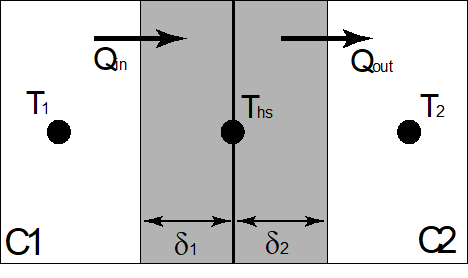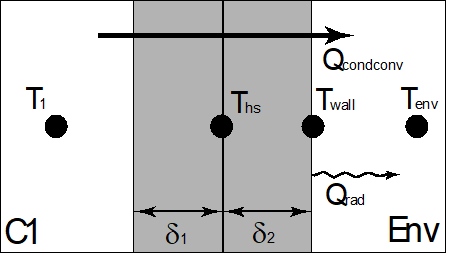![]() Heat Sink equations
Heat Sink equations
![]() Heat Sink equations
Heat Sink equations
|
<< Click to Display Table of Contents >>
|
  
|
Heat transfer by convection is characterized by the Reynolds and Prandtl numbers Re and Pr:
![]()
![]()
‘D’ is the variable ‘Re D’ given in the Heat Sink component variables list. Unless stated otherwise, this remains the case for subsequent equations with the variable ‘D’. For channels with a non-circular cross-section, ‘D’ is the hydraulic diameter. For the Reynolds number the velocity u is not defined and must therefore be calculated. The flow velocity depends on the flow type. For the internal heat flux from gas path to heat sink (specified in the gas path component) the mean flow velocity is determined using:
![]() which is the continuity equation.
which is the continuity equation.
In the special case where shaft suffix is specified in the heat sink external heat transfer to ambient table, convection is assumed to be enhanced by rotation. Then the velocity of the external wall is
![]() and Re and Pr can be calculated. In this relation omega is the shaft angular velocity of the shaft to which Heat Sink is connected. ‘D’ is the 'rotating diameter' of the Heat Sink component.
and Re and Pr can be calculated. In this relation omega is the shaft angular velocity of the shaft to which Heat Sink is connected. ‘D’ is the 'rotating diameter' of the Heat Sink component.
Note that for the normal case of a static outside wall, natural convection is assumed and Re is not active unless a constant Re is specified to represent forced convection. Then the user must specify a Nusselt relation without Re in the expression.
For heat transfer to the surrounding environment the Prandtl number is determined from the user defined thermal conductivity and kinematic viscosity of the gas. The specific heat Cp is calculated from the user specified temperature of the environment. If the external conditions are set to the ambient/flight conditions the variables required for the Prandtl number are calculated by GSP.
The heat transfer coefficient used in the calculations is not the regular heat transfer coefficient, but rather a combination of the convective heat transfer coefficient and the conductive heat transfer coefficient. This relation is given by

The convective heat transfer coefficient is a function of the Nusselt number and the thermal conductivity of the gas,
![]()
![]() ,
,
and the conductive heat transfer coefficient is a function of the thermal conductivity and the thickness of the solid material
![]()
![]() .
.
The convective heat transfer coefficient is determined with the Nusselt number.
![]()
The user specified Nusselt number correlation is specific to the type of flow that occurs.
The heat transfer between the components, Heat Sink and surrounding environment is defined by heat transfer coefficients, interface areas and the temperature difference between the different components and/or the surrounding environment. The heat transfer coefficients are determined from the Nusselt number correlation defined and the parameters to determine the value of the Nusselt number. In this section the mathematical relations required to calculate the total heat rate “Qtotal”, are explained briefly.
In general heat transfers due to conduction, convection and radiation are calculated with the equations
![]() ,
,
![]()
![]()
respectively. The positive directions of heat transfer are indicated by the subscripts of the heat rate Q. The temperatures in these equations are the hot and cold body temperatures of two solids, in case of conduction, or the mean fluid and wall temperature, in case of convection, or the temperature of the wall and surrounding environment in the case of thermal radiation.
Conduction and convection
In GSP the temperatures are defined slightly different. If two different components are connected to each other via a Heat Sink component and operate under steady state conditions, the heat flow Q must be a value such that no heat is stored within the system, i.e. Qin = Qout or in equation form
![]()
A1 is the interface area between component C1 with temperature T1 and the Heat Sink, h1 is the total heat transfer coefficient defined above. The same holds for component C2.

Graphical representation of one Heat Sink connected to two component: C1 and C2.
The figure above shows a graphical representation of the connection of two components and one Heat Sink. The temperature difference between the component C1 and Heat Sink component is given by (T1-Ths). In a regular heat transfer problem consisting of a convection-conduction-convection mechanism, the temperatures of the gas flows could be known and the wall temperatures and heat transfer rate of the conductive material have to be determined. In the GSP model the solid material has a single temperature, Ths. This temperature is determined such that Qin = Qout, and can be visualized as an average or bulk temperature of the two wall temperatures.
The conductive layer thickness, delta_i, is defined such that it represents the distance from a connecting component to the center of the Heat Sink. To have a good representation of actual heat transfer, the values for the conductive layer thickness of components having a mutual heat transfer must be such that the sum matches the actual thickness.
Radiation
The above analysis includes only conduction and convection. If radiation is also included in the simulation, the wall temperature needs to be calculated using
![]()
which can be rewritten to ![]() .
.
The overall heat transfer model including radiation can be represented by the following figure

Graphical representation of thermal radiation of the environment in combination with convective and conductive heat transfer
Introducing thermal radiation into this model changes the thermal equilibrium of the heat sink. The correct Twall is obtained during the iteration towards the gas turbine operating point. The emissivity epsilon of the material is a dimensionless quantity which has a value between 0 and 1. It is the ratio of energy actually radiated by a particular material to the energy radiated by a black body (a hypothetical object that absorbs all electromagnetic radiation that falls on it) at the same temperature.